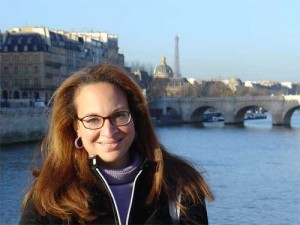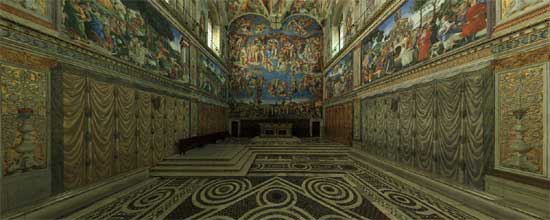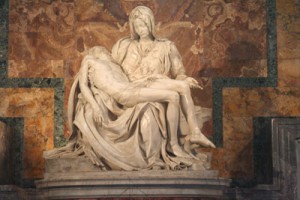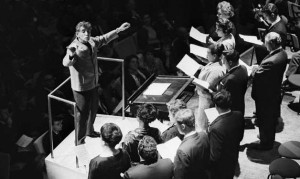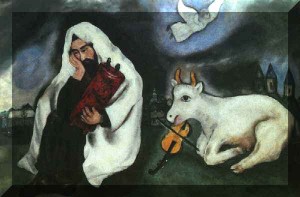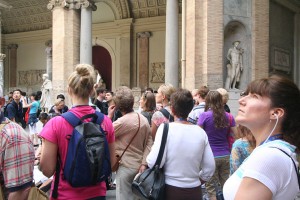 Mike Aquilina give us an overview of the great saints life and impact on the Church
Mike Aquilina give us an overview of the great saints life and impact on the Church
[powerpress]
St. John of Damascus, not only taught that icons and other sacred artworks are permissible because they point to the incarnation of Jesus, but he also understood the rich value of every word to do the same. He is considered one of the Church’s most gifted poets. Every sacred image, whether in art, hymn, poetry can be a prayer that leads us deeper into the heart of God.
The St. John Damascus site contains many of his writings…it’s fantastic!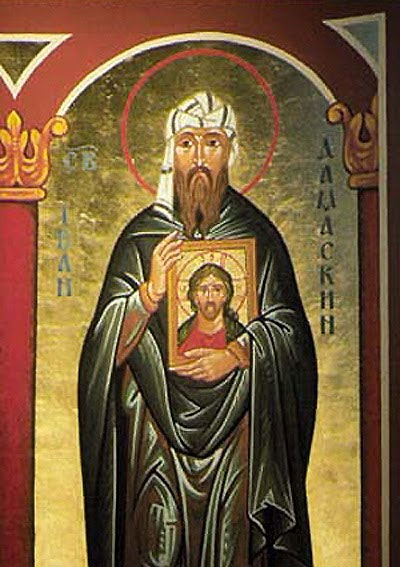
“RIGHTEOUS JOHN OF DAMASCUS. He was raised in Damascus, Syria, the capital of the Moslem world. When he was ten years of age, his father found a learned monk in the secular studies as well as music and theology. He instructed John and his adopted brother, Cosmas, and John made great progress in theology. At last, the monk departed saying to their father, Sergius, that his sons had become remarkably wise. Sergius soon died, and John was chosen for his office of counselor to the caliph.
During this time, John wrote convincingly against the iconoclasts and Leo the Armenian, as well as the Moslems. He effectively used deductive arguments, history, and parables of the saints. Against the iconoclasts, he argued that since the shadows and handkerchiefs of the apostles healed the sick, why was it not appropriate to venerate their icons. His letters were circulated to strengthen and prepare the people to answer the attacks of the heretics. Seeing this, the emperor wrote a letter in John’s hand that had him condemned to the caliph for whom he worked. The caliph had his right hand cut off and hung in the market place. That night, John recovered his hand and prayed before an icon of the Theotokos, called of the three hands, promising that he would write hymns for Orthodoxy if he were healed. He slept, and she told him that he was healed and to write. The caliph freed him, and he became a humble monk. He wrote canons, troparia, idiomela, festal homilies for feast days of Jesus and the Theotokos, the saints and prophets. He established the Typikon, the order of services. He became the mouth piece of all the bishops of the east. He died peacefully at 104 years of age.” – from the St. John of Damascus Institute site – for a longer account go there
Spiritual Writings:
Exposition of the Faith
The video contains some of St. John Damascus’ teachings on the Blessed Virgin Mary
A Prayer of St. John of Damascus
I stand before the gates of thy Temple, and yet I refrain not from my evil thoughts. But do thou, O Christ my God, who didst justify the publican, and hadst mercy on the Canaanite woman, and opened the gates of Paradise to the thief; open unto me the compassion of thy love toward mankind, and receive me as I approach and touch thee, like the sinful woman and the woman with the issue of blood; for the one, by embracing thy feet received the forgiveness of her sins, and the other by but touching the hem of thy garment was healed. And I, most sinful, dare to partake of thy whole Body. Let me not be consumed but receive me as thou didst receive them, and enlighten the perceptions of my soul, consuming the accusations of my sins; through the intercessions of Her that without stain gave Thee birth, and of the heavenly Powers; for thou art blessed unto ages of ages. Amen.
Tags: art, Church, father, fathers mike, icons, john of damascus, mike aquilina, sacred image, secular studies, st john of damascus
This entry was posted on Wednesday, December 4th, 2013 at 12:34 am
You can follow any responses to this entry through the RSS 2.0 feed.
From Vatican Radio:
It’s been 500 years since Michelangelo completed work on the celebrated frescos that adorn the ceiling of the Sistine Chapel. On the Eve of the feast of All Saints, the reigning pontiff, Pope Julius II, solemnly dedicated the monumental work.
Earlier this week, Pope Benedict XVI, following in the footsteps of his predecessor, celebrated Vespers in the Chapel to commemorate the occasion.
Vatican Radio’s Christopher Wells spoke with art historian and tour guide Dr. Elizabeth Lev about the significance of Michelangelo’s work. “In a world where people are always looking forward to the next new thing, and the next hot thing, and the next novelty, that there is still a place where people look backwards and they look in awe at a tradition and a manifestation of what is clearly faith and art, is really quite an amazing thing.â€
Dr. Lev speaks about the central focus of the ceiling, and its relevance for people today. “Michelangelo . . . reduced the story to the human figure. And you see God as an actor, God moving, God interested in that which He creates. He’s physically engaged in the act of creation. I think to begin with, to see a God that wants to be involved is already unbelievably hopeful to people.â€
The Sistine Chapel, she says, speaks to all people: “And then we see the centrality of the creation of man, and how important man is, and that, no matter who you are or where you come from, you can see yourself reflected in that ceiling . . . An innumerable number of people can look in that ceiling and see themselves reflected, and see themselves reflected as beautiful, as heroic, as extraordinary – which is what human beings are. And that makes the Sistine Chapel universal. But of course ‘universal,’ I believe, is the definition of Catholic . . .â€
Listen to the complete interview of Dr. Elizabeth Lev with Christopher Wells: [powerpress]
Tags: art, beauty, sistine chapel
This entry was posted on Tuesday, November 6th, 2012 at 4:21 am
You can follow any responses to this entry through the RSS 2.0 feed.
On Wednesday Pope Benedict XVI challenged the men and women of today’s
world to recover the deepest meaning of art, in its multitude of expressions, but particularly as the path of beauty which leads to God. And in doing so he also shared personal memories of how art had moved him to God with the five thousand pilgrims gathered for the general audience in the tiny village of Castel Gandolfo.
He said “On several occasions during this period, I have recalled the need for every Christian to find time for God, for prayer, amid the many occupations of our daily lives. The Lord Himself gives us many opportunities to remember Him. Today I will touch briefly on one of these channels that can bring us to God and also be of help in encountering Him: it is the path of artistic expression, part of that “path of Beauty “, of which I have spoken several times and which man today should recover in its deepest meaningâ€.
Pope Benedict continued “perhaps sometimes, before a sculpture, a painting, a few verses of a poem or a song, you have experienced deep within an intimate emotion, a sense of joy, that is, you have clearly perceived that in front of you there was not only mere matter, a piece of marble or bronze, a painted canvas, a series of letters or a combination of sounds, but something bigger, something that speaks, capable of touching the heart, of communicating a message; of elevating the soul. ”
“Works of art are the fruit of human creativity, which question the visible reality, trying to discover its deep meaning and to communicate it through the language of shapes, colours, sounds.” The work of art, in short, “is an open door on the infinite,” which “opens the eyes of the mind, of the heart.”
However, he added, “there are artistic expressions that are true paths to God, the supreme Beauty, indeed they help nurture our relationship with Him in prayer. These are works that are born of faith and express faith. One example of this is when we visit a Gothic cathedral; we are enraptured by the vertical lines that shoot up towards the sky and draw our eyes and our spirits upwards, while at the same time, we feel small, and yet eager for fullness … Or when we enter a Romanesque church: we are spontaneously invited to recollection and prayer. We feel as if the faith of generations were enclosed in these splendid buildings. Or, when we hear a piece of sacred music that vibrates the strings of our heart, our soul expands and helped to turn to God. A concert of music by Johann
Sebastian Bach, in Munich, directed by Leonard Bernstein, again comes to my mind. Afterthe last piece of music, one of the Cantate, I felt, not by reasoning, but in my heart, that what I heard had conveyed to me truth, something of the truth of the great composer’s faith and this pressed me to praise and thank the Lord and beside me was the Lutheran Bishop of Munich and spontaneously, feeling this, I said to him, you know, its true, a faith and beauty so strong and irresistibly expresses the presence and truth of God”.
Pope Benedict then turned spoke of how certain artists have touched our lives : “How many times have paintings or frescoes, the fruit of the faith of the artist, in their forms, their colours, their light, encouraged us to direct our thoughts to God and nourished in us the desire to draw from the source of all beauty. What the great artist, Marc Chagall, once
wrote remains true, that for centuries painters have dipped their paintbrush in that coloured alphabet that is the Bible. How many times, then can artistic expressions be occasions to remind us of God, to help our prayer or for the conversion of the heart! Paul Claudel, a poet, playwright, and French diplomat, in the Basilica of Notre Dame in Paris, in 1886, while he was listening to the singing of the Magnificat at Christmas Mass, felt God’s presence. He had not entered the church for reasons of faith, but to in search of arguments against Christians, and instead the grace of God worked in his heart”.
The Holy Father concluded: “I invite you to rediscover the importance of this path for prayer, for our living relationship with God. The cities and towns all over the world preserve works of art that express the faith and remind us of our relationship with God. Visiting places of art, it is not only an occasion for cultural
enrichment, but above all it can be a moment of grace, an encouragement to strengthen our relationship and our dialogue with the Lord, to stop and contemplate, in the transition from simple external reality to a deeper reality, the ray of beauty that strikes us, that almost wounds us in our inner selves and invites us to rise towards God. “
And then he greeted all English speaking pilgrims present: I am pleased to greet the English-speaking pilgrims and visitors here today, especially those from Scotland and Malta. Today we reflect on the need to draw near to God through the experience and appreciation of artistic beauty. Art is capable of making visible our need to go beyond what we see and it reveals our thirst for infinite beauty, for God. Dear friends, I invite you to be open to beauty and to allow it to move you to prayer and praise of the Lord. May Almighty God bless all of you!
Tags: art, catholic, catholic podcast, catholic prayer, cathollc spirituality, music, pope benedict xvi, prayer
This entry was posted on Thursday, September 1st, 2011 at 1:00 am
You can follow any responses to this entry through the RSS 2.0 feed.
Tags: Andrea Bocelli, art, ave maria, catholic, catholic podcast, catholic prayer, cathollc spirituality, Raffaello Sanzio, raphael
This entry was posted on Monday, August 1st, 2011 at 7:20 pm
You can follow any responses to this entry through the RSS 2.0 feed.

